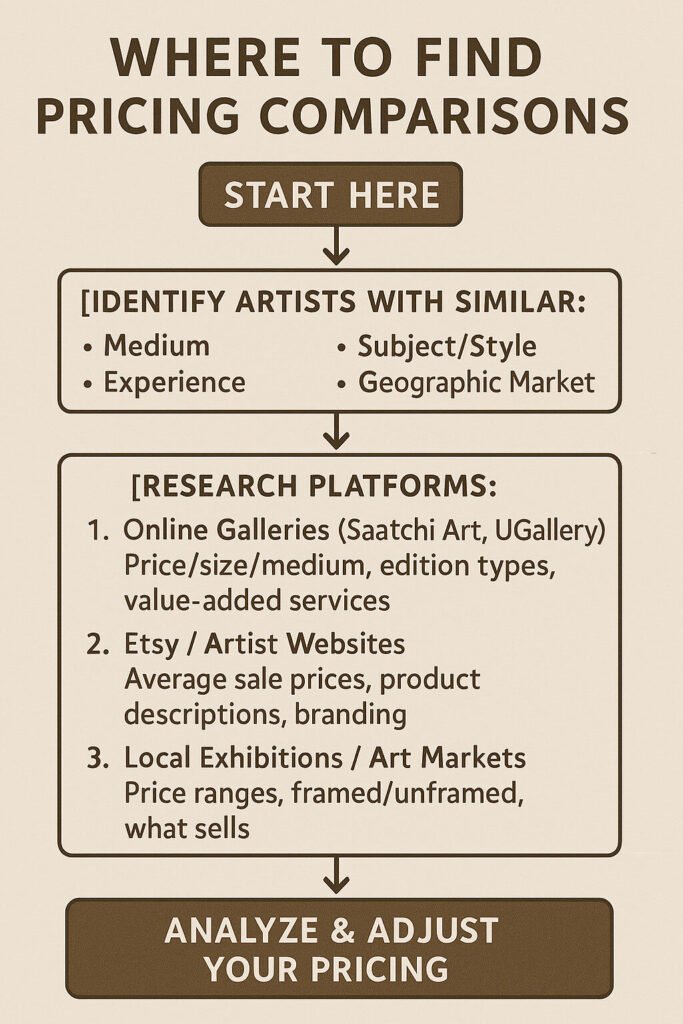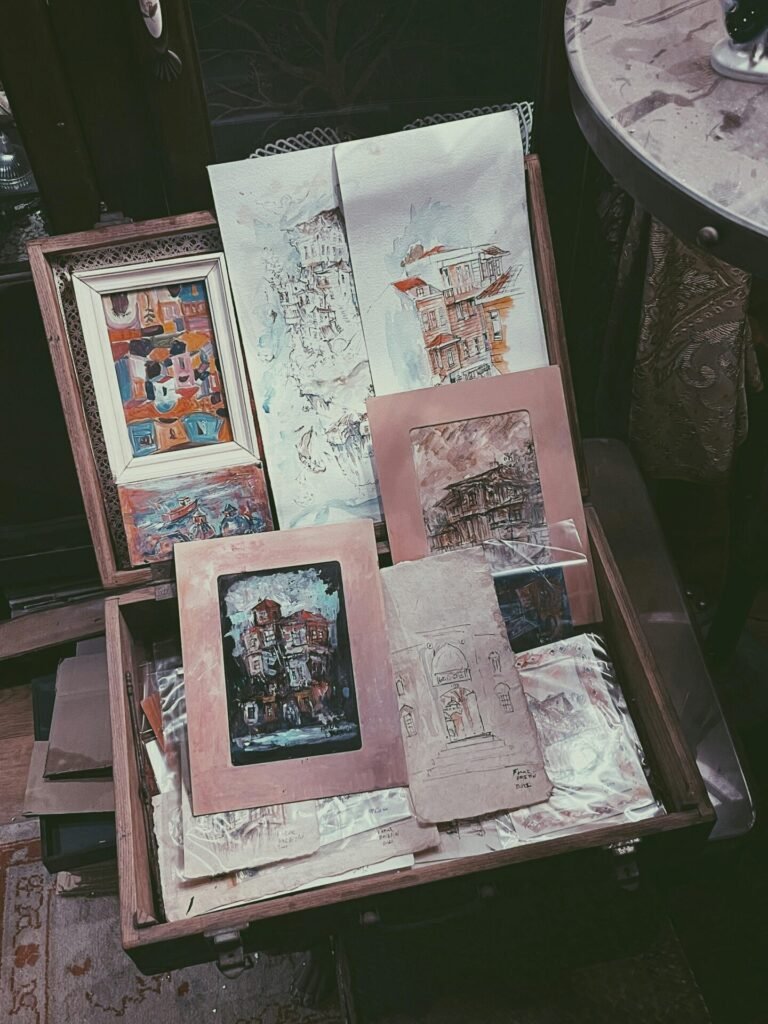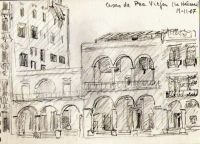Why Fair Pricing Matters
Knowing how to price your original art and prints fairly is one of the most important—and often most confusing—aspects of building a sustainable creative practice. Set your prices too low, and your work risks being undervalued; too high, and you might alienate buyers before they’ve had a chance to appreciate your talent. The key lies in balance, perception, and professionalism.
Pricing isn’t just about covering materials or calculating time—it communicates your value as an artist. A thoughtful pricing structure helps build trust with collectors, supports long-term artistic growth, and establishes your credibility in the creative marketplace.
Pricing art fairly also makes your work more approachable to a wider audience, particularly when offering reproductions like fine art prints, zines, or limited edition merchandise. Artists who take time to establish a fair value for both originals and prints are better positioned to grow steadily without burning out or plateauing.
Understanding the Value of Your Work
Before crunching numbers, start with an honest evaluation of your work:
- Skill and experience level
- Hours invested in creation
- Material and tool costs
- Complexity and uniqueness of the piece
- Emotional, narrative, or historical value
- Market demand and audience base
These factors help contextualize your art within the larger ecosystem. No two works are priced alike—but consistency in your logic will help you and your buyers build mutual confidence.

Why Pricing Matters More Than You Think
Pricing your original art and prints isn’t just about covering costs—it’s a reflection of how you position yourself as a professional artist. A clear and fair pricing structure helps build trust with collectors, avoid undercutting, and sustain your practice long-term. It also contributes to brand identity, reinforcing the perceived quality of your work in both local and online art markets.
Emotional Barriers to Confident Pricing
Many artists struggle with internal doubts when attaching a dollar amount to their creations. You might question whether your work is “worth it,” or fear alienating potential buyers. These feelings are common, but underpricing can devalue not only your own art, but the creative industry as a whole. Building confidence in your pricing starts with education, experience, and consistency.
Market Value vs. Personal Worth
It’s important to separate emotional attachment from market positioning. A piece may have immense personal significance, but buyers evaluate based on factors like craftsmanship, uniqueness, size, and demand. Think of your pricing as a communication tool—it says “This is the level of professionalism, care, and originality you’re purchasing.”
Common Pricing Models
Why Use Pricing Models at All?
Having a clear system keeps your pricing fair, consistent, and justifiable—whether you’re speaking to seasoned collectors or first-time buyers. The best model depends on the nature of your work, how long it takes to create, and how you want to scale. Many artists find success blending multiple methods over time.
Time + Materials Formula
Simple, Practical, and Grounded in Your Effort
This model is straightforward and especially useful when you’re starting out or working on commissions. It helps ensure you’re at least covering costs and being paid for your time.
How to calculate:
- Add up all material costs (paper, paint, canvas, ink, varnish, etc.)
- Multiply your hourly rate by hours worked (e.g., $30 × 10 hours = $300)
- Add framing or presentation expenses if applicable
Example:
Materials: $50
Labor (10 hours × $30): $300
Framing: $75
Total price = $425
Use this to build confidence and avoid underpricing, especially for bespoke or labor-intensive pieces.
Per Inch Formula
Scalable Pricing Based on Artwork Size
This model uses surface area to create a simple, repeatable formula that adjusts with the size of your artwork. It’s especially useful for 2D artists who want pricing consistency across a series or print run.
Formula:Width × Height × Rate = Final Price
Example:
18″ × 24″ × $2.50 = $1,080
Rate ranges:
- Emerging artists: $1–$2/sq inch
- Mid-career or regionally known: $2.50–$4/sq inch
- Established or in-demand artists: $5–$6+ per sq inch
This method is ideal if you offer standard sizes or create work that can be measured easily for prints or originals.
Tiered Pricing
Match Your Market with Multiple Price Levels
This flexible model is excellent for artists who offer both originals and reproductions across different formats.
Three typical tiers:
- Originals: Unique and handcrafted—priced at a premium to reflect exclusivity and labor.
- Limited Edition Prints: Signed and numbered in small runs. Higher price than open editions due to scarcity and perceived value.
- Open Edition Prints: Unlimited quantity, ideal for accessibility and broad appeal. Lower price point, often sold online or at fairs.
Tiered pricing helps you:
- Reach a wider customer base
- Reuse artwork across formats
- Generate recurring income from one design
It’s particularly effective for building a long-term collector base while keeping your work approachable.
Pricing Prints vs. Originals
Understanding the Value Difference
Originals and prints serve distinct roles in your artistic offering. Originals are one-of-a-kind works that carry the full weight of your time, experimentation, and physical labor. They’re priced to reflect exclusivity, craftsmanship, and creative risk. Prints, on the other hand, are reproducible and more accessible—ideal for reaching broader audiences and generating recurring income.
Key Factors When Pricing Prints
To avoid guesswork and protect the integrity of your original work, consider the following variables:
1. Printing Costs and Packaging
Start with hard costs like high-quality printing, archival paper, ink, packaging supplies, and shipping materials. Whether you print in-house or work with a fine art printer, get clear on per-piece costs—including test runs and potential waste.
2. Edition Size
Smaller editions (e.g., runs of 10–50) create a sense of exclusivity and justify higher prices. Large or open editions are more affordable and suitable for commercial or gift-oriented buyers. Edition size also impacts how collectors view value and rarity.
3. Balanced Markup
A general rule of thumb is to price your print at 2x to 3x your cost of production to account for profit margin, labor in prepping files, and administrative overhead. If a print costs $15 to produce, pricing it at $30–$45 keeps it both sustainable and competitive.
4. Prints vs. Originals Relationship
Your print pricing should always support—not compete with—your original works. If an original sells for $200, pricing corresponding prints between $30–$60 keeps the perceived value of the original intact while offering accessibility.
Offer Flexible Formats
Adding options like framed vs. unframed, paper types (cotton rag, matte, canvas), or alternate sizes creates tiered price points without muddying your overall structure. Just ensure each format has clear value separation and doesn’t cannibalize interest in higher-priced originals.
Market Research and Comparable Pricing
Why Market Awareness Supports Fair Pricing
Understanding your creative worth doesn’t happen in a vacuum—it takes context. By researching how similar artists price their work, you gain a clearer view of what collectors are willing to pay and what’s considered competitive within your niche. Market research isn’t about copying someone else’s price tag; it’s about carving out your place on a shared spectrum of value, demand, and visibility.
Where to Find Relevant Comparisons
To do this well, look for artists who share at least two of the following:
- Similar medium (e.g., watercolor, acrylic, ink)
- Comparable experience or exhibition history
- Parallel subject matter or stylistic approach
- Similar geographic market (especially important for local sales)
Here’s where to start your search:
Online Galleries and Curated Platforms
Websites like Saatchi Art, UGallery, or Artfinder showcase a wide variety of contemporary artists. Look for artists with work similar to yours, then observe:
- Price per size/medium
- Edition types (original vs. print)
- Framing, packaging, or value-added services
Compare how your technique and presentation stack up—are they pricing higher due to reputation, or is there room for you to raise yours?
Etsy and Artist Websites
Etsy can be particularly useful for print pricing, especially if you sell open editions, zines, or affordable originals. Examine:
- How they write product descriptions
- Average sale prices across shops with strong reviews
- Price variations based on size or format
Artist-run websites also give insight into branding tone, story, and buyer incentives—like bundles, free shipping, or loyalty discounts.
Local Exhibitions and Art Markets
In-person art shows provide context for pricing in your immediate community. Observe:
- Price ranges for similar works and sizes
- Whether pieces are framed/unframed
- What seems to be selling (look for red dots or ask politely)
- How artists talk about pricing with customers
Sometimes, simply attending a local market and talking with fellow artists provides more insight than hours online.
Read Between the Price Tags
Pricing isn’t just numbers—it’s tied to perceived value. Take note of:
- Presentation: Are their photos high-end? Do they offer certificates of authenticity?
- Branding: Is their pricing supported by consistent visual identity and storytelling?
- Engagement: Do they have strong social followings or media features that justify higher pricing?
Identifying what elevates their work in the market helps you determine what to adopt, what to improve, and how to communicate your own value effectively.

PRO TIPS
Avoiding Common Pricing Mistakes
Why These Mistakes Matter More Than You Think
Pricing errors can quietly erode your reputation, profitability, and long-term confidence. While they often seem small in the moment—like offering a quick discount or trimming a price for a friend—these decisions create patterns. Over time, they shape how your art is perceived and how sustainable your business becomes. Let’s break down the most common missteps and how to avoid them with clarity and consistency.
Inconsistency Across Platforms
When your prices fluctuate depending on where your work appears, it confuses buyers and undermines trust. Whether you’re selling through your own website, an online marketplace like Etsy, or an art fair booth, pricing should remain consistent. If necessary, factor in additional fees (like gallery commissions or shipping platforms) behind the scenes rather than altering the public-facing price.
Consistency signals professionalism and builds buyer confidence.
Underpricing to Sell Quickly
Tempting as it may be, regularly lowering prices to “move pieces” can backfire. Underpricing makes it harder to raise your prices later, and may attract bargain hunters instead of long-term collectors. It also risks sending the message that your work isn’t worth much—regardless of skill or quality.
Instead, work on positioning, presentation, and outreach. Let perceived value grow through storytelling, visibility, and quality documentation.
Ignoring Upgrades and Packaging
Many artists forget to account for finishing touches like:
- Varnishing or sealing
- Matting or framing
- Protective packaging (tissue, kraft paper, bubble wrap)
- Handwritten notes or certificates of authenticity
Even if these touches feel minor, they add time, cost, and perceived value. Make sure they’re included in your pricing calculations so your profit margin isn’t quietly shrinking behind the scenes.
Not Accounting for Taxes or Fees
Whether you’re selling through a platform that takes a percentage, accepting payment via credit card apps, or navigating state/local tax rules, those extra costs add up. If you don’t bake them into your price or track them carefully, you’re effectively absorbing those expenses as losses.
Be proactive about:
- Researching sales tax responsibilities for your location
- Adding a small margin for processing fees
- Reviewing platform policies for commission structures
With careful planning, you protect your margins without surprising your buyers.
Common Pricing Mistakes to AVOID:
1. INCONSISTENCY ACROSS PLATFORMS:
* PROBLEM: Confuses buyers, undermines trust.
* SOLUTION: Consistent public pricing; factor fees internally.
2. UNDERPRICING TO SELL QUICKLY:
* PROBLEM: Hard to raise prices later, attracts bargain hunters.
* SOLUTION: Focus on positioning, presentation, outreach.
3. IGNORING UPGRADES & PACKAGING COSTS:
* PROBLEM: Erodes profit margins.
* SOLUTION: Include varnishing, framing, packaging, COAs in calculations.
4. NOT ACCOUNTING FOR TAXES OR FEES:
* PROBLEM: Absorbing expenses as losses.
* SOLUTION: Research sales tax, add margin for processing fees, review platform commissions.
Tell the Story
Communicating Value to Buyers
Why Perceived Value Goes Beyond the Artwork Itself
In today’s art market, buyers aren’t just purchasing an image—they’re investing in a story, a connection, and the experience of owning something meaningful. Your role isn’t just to create—it’s to communicate the value of what you’ve created. Every step in how you present, describe, and deliver your work reinforces its worth in your buyer’s eyes. When done well, this communication builds trust, boosts perceived professionalism, and encourages repeat purchases.
Tell the Story Behind the Piece
Artwork descriptions shouldn’t just state the medium and size—they should spark curiosity and emotional connection. A great description answers the invisible questions buyers might be thinking:
- What inspired this piece?
- What emotions or memories does it explore?
- What was your process like?
- Is there symbolism or personal relevance embedded in the work?
You don’t need to write an essay—just a few thoughtful lines can shift your work from a product to a conversation starter.
Use Titles That Invite Interpretation
A compelling title can elevate a piece from interesting to unforgettable. Avoid generic labels like “Untitled” or “Study #3” when possible. Instead, use language that offers a hint of narrative, emotion, or symbolism—something that enhances the buyer’s sense of meaning and ownership.
Examples:
- “Softly, After the Rain”
- “Frequencies of Memory”
- “Nocturne in Indigo”
Elevate the Presentation Experience
Buyers notice when care is taken beyond the canvas. These small upgrades reinforce professionalism and value:
- Certificates of authenticity: Hand-signed or digital, these create permanence and add collector credibility.
- Packaging: Use acid-free tissue, durable mailers, or sustainable wrapping materials. Bonus: include a branded sticker or thank-you seal.
- Handwritten notes: A short message adds warmth and shows the buyer they’re not just a transaction.
- Care instructions: Especially helpful for prints, mixed media, or delicate finishes—it shows thoughtfulness and helps prevent returns.
These efforts convey that your art is premium, cared for, and worth preserving.
Polish Your Online Presence
From website layout to portfolio photos, your digital storefront is often the first impression buyers get. To reinforce your pricing and professionalism:
- Use high-resolution, well-lit images on neutral backgrounds
- Include scale references when possible (e.g., artwork in a room)
- Format product pages consistently—title, description, size, medium, price
- Remove broken links or outdated listings
- Match your tone and visuals across your site, Etsy store, and social platforms
Professional presentation builds credibility—and encourages browsers to become buyers.
Communicating Your Art’s Value:
1. TELL THE STORY BEHIND THE PIECE:
* WHAT: Inspire, emotion, process, symbolism.
* WHY: Shifts work from product to conversation starter.
2. USE TITLES THAT INVITE INTERPRETATION:
* WHAT: Narrative, emotion, symbolism (e.g., “Softly, After the Rain”).
* WHY: Elevates piece, enhances meaning.
3. ELEVATE THE PRESENTATION EXPERIENCE:
* WHAT: COAs, thoughtful packaging, handwritten notes, care instructions.
* WHY: Reinforces professionalism, value, and encourages repeat purchases.
4. POLISH YOUR ONLINE PRESENCE:
* WHAT: High-res images, consistent formatting, scale references, strong branding.
* WHY: Builds credibility, converts browsers to buyers.

Sketchbooks.org | TRADITIONAL TECHNIQUES
How to Develop a Unique Hand Lettering Style
Unique Hand Lettering Style That Grows From the Page Developing a unique hand lettering style is a blend of practice, inspiration, and exploration. Your sketchbook is your personal lab—where ideas evolve and where style blossoms....
Frequently Asked Questions
How do I choose between hourly vs. per-inch pricing?
Use hourly rates for unique commissions; use per-inch for consistent pricing across collections.
What should I charge for a small print?
Base it on printing cost, labor, and desired markup—often between $15 and $50 for 8×10 or smaller.
How do I price artwork for galleries?
Expect galleries to take a commission (usually 30–50%), so raise your prices to ensure you still profit.
Should I price prints much lower than originals?
Yes, but maintain enough value in prints to avoid devaluing your originals.
Can I change prices later?
Yes, especially as your skill and reputation grow—just do so intentionally and communicate clearly.
What’s a fair hourly rate for an emerging artist?
Many start at $20–$40/hour; this can increase with demand and professional standing.
Should I offer discounts or sales?
Occasionally is fine, but avoid habitual discounts that train buyers to wait for deals.
How can I justify my prices to buyers?
Clearly communicate your process, quality, and the uniqueness of your vision—transparency builds trust.
Final Thoughts
Learning how to price your original art and prints fairly isn’t about chasing perfection—it’s about building confidence and clarity over time. Pricing is both a creative and business skill that evolves alongside your experience, audience, and offerings. The more intentional you are, the easier it becomes to balance accessibility with value, emotion with economics.
Remember: your art holds meaning, and that meaning deserves a price that sustains—not just your practice—but your purpose. Stay grounded, stay flexible, and know that the right collectors will recognize and support the integrity behind your work.
Ready to Share Your Work?









Underselling my work used to feel humble, but now it feels off-brand.